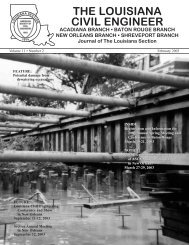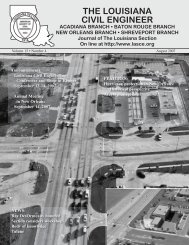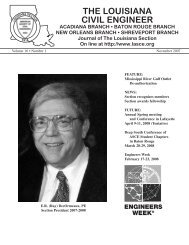THE LOUISIANA CIVIL ENGINEER - lasce
THE LOUISIANA CIVIL ENGINEER - lasce
THE LOUISIANA CIVIL ENGINEER - lasce
Create successful ePaper yourself
Turn your PDF publications into a flip-book with our unique Google optimized e-Paper software.
Commencement address<br />
By E. R. Desormeaux, PE<br />
Dean Zappi, Members of the Faculty and<br />
Administration, Honored Guests, and Graduates.<br />
In my family, as I am sure it is in yours, Where<br />
were you on a particular day?... has been a frequent<br />
question at many family gatherings. In my<br />
lifetime, there have been several dates with enormous<br />
meaning:<br />
• December 7, 1941 A date that will live in<br />
infamy. — the attack<br />
on Pearl Harbor<br />
• June 6, 1944 D-Day — the allied<br />
invasion of Europe<br />
• August 6, 1945 Hiroshima — the first<br />
atomic bomb<br />
• November 22, 1963 President John F.<br />
Kennedy assassinated<br />
• July 20, 1969 Neil Armstrong lands<br />
on the moon<br />
• September 11, 2001 destruction of the<br />
World Trade Center —<br />
9/11<br />
There are some natural disasters in our country<br />
with a similarly enormous meaning:<br />
• October 17, 1989 Loma Prieta<br />
Earthquake in San<br />
Francisco<br />
• January 17, 1994 Northridge Earthquake<br />
• August 29, 2005 Hurricane Katrina<br />
As an infant or young child when Pearl<br />
Harbor and some other events I listed occurred, I<br />
(Continued from Page 13)<br />
Jacques Gilbert presents paper during the<br />
Daniel W. Mead competition.<br />
was too young to remember them as a firsthand<br />
experience. However, in our extended family,<br />
especially with so many uncles who served in<br />
World War II, the conversations I overheard during<br />
family gatherings usually revolved around<br />
what the older family members were doing on a<br />
particular day in history.<br />
The day President Kennedy was assassinated,<br />
I was a young project engineer, sitting in my<br />
car on the runway of the Lafayette Airport<br />
observing the construction work being performed.<br />
My wife called me with the news. She<br />
was crying. And so did I.<br />
When Neil Armstrong landed on the moon, I<br />
was sitting in my home watching it intently on<br />
my television with great anticipation as Walter<br />
Cronkite kept us updated.<br />
During 9/11, I was on a job site watching<br />
steel erectors install steel columns and beams for<br />
a building. This was while evil men destroyed 2<br />
great buildings — Ironic!<br />
For days before and after Hurricanes Katrina<br />
and Rita, I sat in my office or in my home with<br />
eyes fixed on the television. I watched the devastation<br />
of coastal Louisiana with awe and particularly<br />
the devastation of a great city.<br />
If someone asks, Where were you?... each<br />
one of you remembers and probably will remember<br />
where you were and what you were doing on<br />
9/11, and especially on August 29, 2005.<br />
Tynekia sat on a chair on the wall; Tynekia<br />
could have had a great fall; But William and<br />
Alex caught chair and all!<br />
In the subsequent weeks following<br />
Hurricanes Katrina and Rita, I was never so<br />
proud to be an engineer. I witnessed the many<br />
engineers throughout the United States and the<br />
world at their best responding to the needs of fellow<br />
engineers and other citizens of Louisiana.<br />
Many of us serving in the professional engineering<br />
societies began to receive calls from<br />
people we knew, and from some we did not<br />
know. All of them wanting to know how they<br />
could help.<br />
I received calls and e-mails from engineers<br />
in Switzerland, the Netherlands, and France<br />
expressing their deep sorrow for our dilemma in<br />
the great catastrophe. They wished that they<br />
could be here to lend whatever help they could.<br />
We received contributions — money and<br />
services — from engineers throughout the USA,<br />
including Las Vegas, Kentucky, and Florida, just<br />
to name a few. An engineer from Indiana — an<br />
owner of a large consulting firm — took a special<br />
vacation. He drove to New Orleans with his<br />
wife who is a nurse. He spent 10 days assisting<br />
where he could while his wife worked in a triage<br />
unit. That man — a person I did not know before<br />
Hurricane Katrina — has now become a good<br />
friend.<br />
As proud and thankful as we are about the<br />
great response of the American people, and our<br />
(Continued on Page 20)<br />
The Concrete Horseshoes event is the only<br />
event in which the Chapter placed. We came in<br />
3rd. The team, Ineaka Carbo, Brandon Johnson,<br />
Derwin Young and Quenton Richardson, spent a<br />
great deal of time preparing the horseshoes to<br />
specification.<br />
Constructing the concrete horseshoes was a<br />
challenging and a fun experience because we<br />
were able to create something using our knowledge<br />
of materials and problem-solving skills.<br />
The competition gave us hands-on experience<br />
with the trial-and-error that is often involved in<br />
engineering design.<br />
We had to try different concrete mixes, but<br />
designing an effective mold for the horseshoes<br />
was also a challenge. We made our first mold out<br />
of wood, however, the problem was reproducing<br />
horseshoes that would meet the specified dimensions.<br />
The wood mold presented other problems.<br />
Our second mold was sloppy but effective - only<br />
if we were creating a horseshoe that would easily<br />
break. With the help of our school technician<br />
Rory Nettles, we developed a mold using hog<br />
casing. It was very smelly and nasty but a great<br />
idea. Because the casing was so thin we were<br />
able to form a perfectly sized horseshoe, but we<br />
were not able to stuff the casing because of the<br />
concrete mix we were using.<br />
A couple of weeks before the competition<br />
we came up with the brilliant idea of creating a<br />
mold from the kids’ toy, Play-Doh. Using this<br />
mold, we were able to create perfect horseshoes<br />
in dimension and weight once the mix was perfected.<br />
In fact, ours was the only team who had<br />
all seven shoes meet the size and weight requirements.<br />
Other teams had to make adjustments<br />
such as shaving to make some shoes meet the<br />
specifications. After all of the other trams had<br />
broken all 6 of their competition horseshoes, we<br />
still had 3 left. It is too bad the competition was<br />
not based strictly on durability. We would have<br />
taken 1st place for sure!<br />
Preparation for some events required us to<br />
spend a lot of time together working as a group,<br />
and it really made us grow as a chapter. If we<br />
maintain our momentum, we will finish this<br />
semester and this year on a pretty high note.<br />
The Chapter is planning a crawfish boil for<br />
the weekend of May 6th to celebrate our accomplishments<br />
and reward our chapter members and<br />
our seniors. We plan to hold an Order of the<br />
Engineer ring ceremony early in the fall semester,<br />
and to attend the ASCE National Conference<br />
in Chicago this year.<br />
<strong>THE</strong> <strong>LOUISIANA</strong> <strong>CIVIL</strong> <strong>ENGINEER</strong> / MAY 2006 19






